Awes
-
- WORLD SHIPBUILDING Maritime Reporter, Jun 1989 #46
New Orders Up For Second Year In A Row According to Drewry Shipping Consultants Ltd., London, England, an aging world fleet (27 percent of the fleet is more than 15 years old), should provide the world's shipbuilding industries with a modest increase in work based primarily on replacement tonnage. The major market for builders in the early/ middle 1990s will be, according to Drewry, the construction of tankers and, in particular, VLCC tonnage.
Tonnage of this size is still the most economic way to move crude oil, and vessels in the 250,000-280,000-dwt range will increasingly be in demand as 1970s-built tonnage is scrapped.
Drewry predicts aggregate newbuilding demand in the period up to 1997 will be 330 million dwt (200 million grt), with tankers accounting for nearly 40 percent of total output. Of this figure, VLCC demand is estimated to be over 70 million dwt, i.e. nearly 300 vessels.
This optimistic view seems to be backed by a recent report entitled "Outlook for the World Shipping Market 1988-2000," published by the City University Business School of London. The report predicts that shipbuilding output in deadweight tons will nearly double in the next five years. The forecast is based on continued world demand for bulk freight, higher average dry cargo time charter rates, and scrapping of more tankers and dry cargo vessels as they become older and world metal prices rise. The report points out that by 1993, more than 55 percent of the tanker fleet will be at least 15 years old, as compared to 18 percent of the world's bulk carrier fleet.
A report published by the Association of Western European Shipbuilders (AWES) also maintains an optimistic outlook. The AWES report forecasts an upward trend in tonnage demand during the next decade as seaborne trade and the world economy continue to grow.
According to the report, by the year 2000, world fleet requirements for gross tonnage will be more than double that of mid-1987. Demand for new ships will occur as laid up and surplus tonnage shrinks and as aging and obsolete vessels are scrapped.
The AWES report predicts that 85 percent of overall newbuilding requirements in deadweight tons will be for oil tankers and bulk carriers.
An extensive report issued by U.K.-based Ocean Shipping Consultants entitled "World Shipbuilding & Newbuilding Prices to 2000," also projects an increase in new tonnage demand for the last decade of this century. Although owners will require only about 38.5-million grt in newbuildings between 1991 and 1995, this demand should rise dramatically, according to the report, to over 132-million grt between 1996 to 2000.
Because of the increase in demand for new tonnage, the report forecasts that the cost of newbuildings will also rise substantially, with prices for certain types of vessels doubling (See Table 1).
total tonnage completed to 10.9 million gross tons. This represents a drop of 1.4 million gt from 1987 figures.
The number of ships completed, however, increased by 47 to 1,575.
Furthermore, for the second year in succession, new orders exceeded completions, indicating an improved outlook for the world shipbuilding industry. Orders placed in 1988 totaled 12.3 million gt, an increase of 1.4 million gt over the total output. The tonnage ordered in 1987 amounted to 13.8 million gt, 1.5 million gt more than the completions during the same period.
Oil tankers accounted for 4.1 million gt of all completions in 1988, an increase of 1.1 million gt from the previous year. Tanker tonnage represented 37.9 percent of all tonnage completed compared with 24.9 percent in 1987 and 22.4 percent in 1986.
There was a drop in the bulk carrier output to 2.3 million gt from the previous year's total of 4.3 million gt- Fully cellular container ship completions amounted to 1.5 million gt, up by 347,000 gt from 1987, while the general cargo ship output totaled 1.9 million gt, down by 321,000 gt- Japan's output, at 4 million gt (down by 1.7 million gt from 1987), represented 37 percent of the world total (46.6 percent in 1987). New orders obtained by Japanese shipyards totaled 4.6 million gt or 37.6 percent of the world total. Of the tonnage completed by Japan, oil tankers accounted for 1.4 million gt and ore/bulk carriers 1.2 million gt.
Number two shipbuilder South Korea increased its total output from 2.1 million gt in 1987 to 3.2 million gt, a jump of over 52 percent.
South Korea's share of the world tonnage output increased from 17.1 percent to 29.1 percent.
New orders totaled 3 million gt, 0.2 million less than their total output.
Of the other leading shipbuilding nations, the People's Republic of China completed 254,000 gt (down 32,000 gt); Republic of China (Taiwan) 453,000 gt (up 111,000 gt); West Germany, 521,000 gt (up 180,000 gt); Denmark, 377,000 gt (up 134,000 gt); East Germany, 292,000 gt (unchanged) and Poland, 275,000 gt (down 13,000 gt).
The largest ship completed in 1988 was the 305,893-dwt ore/oil carrier Alster Ore, built in Taiwan by China Shipbuilding Corp. for Krupp Seeschiffahrt.
During the last quarter of 1988, eight ships of over 200,000 dwt were completed, seven of which were delivered by South Korean shipyards.
The largest ships completed, both delivered by Hyundai Heavy Industries, were the 265,243 dwt oil tankers World Prelude and World Prince for companies associated with World-Wide Shipping Agency Ltd. of Hong Kong. The largest dry cargo ship completion, the 245,609- dwt bulk carrier Ocean Universe, was delivered by Daewoo Shipbuilding & Heavy Machinery Ltd. for Pan Ocean Shipping Ltd.
In the luxury cruise ship sector, the Turku Shipyard of Wartsila Marine Industries Inc. delivered delivered the 768-passenger Royal Viking Sun to Kloster Cruise Ltd.The West German yard of Schichau Seebeckwerft delivered the 212- passenger Seabourn Pride to Seabourn Cruise Line of San Francisco.
World Orderbook Lloyd's Register Merchant Shipbuilding Return for the end of 1988, showed the total world orderbook with 2,228 ships of 24.6 million gt.
Far East Japan regained the leading position in the world orderbook with its 5.96 million gt, overtaking South Korea (5.87 million gt) which had held the lead since the third quarter of 1987. Sixty-one percent of the tonnage in Japan's orderbook was under construction, compared with 39 percent of South Korea's.
The Kobe shipyard of Japan's Mitsubishi Heavy Industries recently received an order to build a 164-passenger cruise ship. The order was placed by Frontier Cruises, a new joint venture of Salen Linblad Cruising, Nippon Yusen Kaisha, Mitsubishi Corp., Hapag-Lloyd and MHI. The ship is expected to be delivered in November 1990.
South Korean shipbuilders Samsung Shipbuilding & Heavy Industries, Co., Ltd. and Daewoo Shipbuilding & Heavy Machin- ery, Ltd. have recently joined forces in an effort to bid for Nedlloyd's 15-containership order estimated to be worth over $1 billion.
Nedlloyd has already received a proposal for the first five ships from a consortium formed by NKK Corporation and Kawasaki Heavy Industries.
Despite labor unrest, South Korean shipbuilding giant Hyundai Heavy Industries, was able to garner a number of impressive orders.
Among the orders were four containerships for West German owners, a 4,300-cubic-meter-capacity LPG carrier for Kosan Tankers of Copenhagen, a RO/RO cargo vessel for Ahlers Lines of Antwerp, five bulkers for Hyundai Merchant Marine (two of 37,000-dwt, two of 200,000 dwt and one of 150,000 dwt), two bulk carriers for Hanjin Container Lines and a bulker for Korea Line Corporation.
Samsung Shipbuilding received a boost when West German shipping company Hapag-Lloyd placed an order for five containerships worth about $347 million. The newbuildings will each have a capacity of 4,400 TEUs and are scheduled for delivery into 1992.
U.S.-based American Telephone & Telegraph (AT&T) awarded two separate contracts worth $100 million to Far East Levingston Shipbuilding to build two cablelaying vessels. The 8,000-ton ships will incorporate state-of-the-art technology. FELS also landed a $100-million contract to build a second oil drilling rig for the Santa Fe International Corp. The Universe Class jack-up rig will be based on designs by Friede & Goldman of the U.S.
At present, FELS is completing a $60-million cantilever rig for Santa Fe.
One of the latest export orders won by China State Shipbuilding Corporation (CSSC) of the People's Republic of China calls for the construction of two 300-TEU feederships for Neptune Orient Lines of Singapore. The 361-foot vessels will be built at the Qiuxin Shipyard.
Europe In Europe, a consortium of yards is also bidding for the Nedlloyd order. Alsthom Chantiers de l'Atlantique of France, West Germany's HDW and Bremer Vulkan, and Van der Giessen de Noord of the Netherlands have formed a consortium in hopes of winning the first batch of orders due to be placed next month.
Portugal's Estalieros Navais de Lisboa (LISNAVE) posted a record-breaking year in the shiprepair sector. With improved productivity and a trimmed workforce, LISNAVE recorded a sales turnover of more than $100 million in ship repair.
Across the border in Spain, stateowned A s t i l l e r o s Espanoles S.A. (AESA) posted an excellent 1988, almost doubling the amount of newbuilding tonnage it acquired in 1987. Boosted by a number of tanker, refrigerated cargo vessel and gas carrier contracts, AESA won orders for 60 vessels totaling 611,914 tons. In 1987, the shipbuilding group won contracts for 19 vessels with an aggregate tonnage of 307,256 tons. One of the latest contracts won by AESA is for two 140,000-dwt Suezmax crude carriers for Seatankers Management.
In the first four months of 1989, West German shipowners increased their orders for new ships, citing an improved shipping outlook and the creation of a second German ship register.
According to the German Shipowners Association, its members ordered 22 vessels totaling 530,500 grt from January to mid-April. The tonnage figure exceeded all German ship orders in 1987 and 1988.
At present, 44 ships totaling 913,000 grt are being built for German shipowners, 20 of which are being built in West Germany.
One of the beneficiaries of the increased orders is the West German shipyard Schichau Seebeckwerft.
Besides being busy with a number of conversions, the yard has an impressive list of new construction. Among its newbuildings, Schichau Seebeckwerft launched the 35,000-grt jumbo-ferry Olau Hollandia, reportedly the largest vessel of her type operating from Germany. The 528-foot ferry has a passenger capacity of about 1,600, and is expected to be delivered this September. Her sister, the Olau Brittania, is under construction at Schichau Seebeckwerft and is expected to be delivered next year.
In January, Schichau Seebeckwerft also delivered the all-around combicarrier Robin Hood to TTLine of Hamburg. The sister vessel of the Nils Dacke delivered last year by Schichau, the Robin Hood has an overall length of 581 feet and deadweight tonnage of 8,800.
L i n d e n a u GmbH, S c h i f f - swerft & Maschinenfabrik of Kiel received an order for a 3,500- dwt clean oil tanker from Ethiopian Shipping Lines, Addis Ababa, Ethiopia. Scheduled to be delivered in October 1989, the product/oil tanker will be equipped with 12 loading tanks. Her cargo tank capacity will be about 4,000 m3.
In the conversion sector, Blohm & Voss re-delivered the passenger/ car ferry Saga Wind to Swedish owner Sea Wind Line, part of the Silja Line Group, after lengthening and engine refit.
The shipbuilding consortium of Bremer Vulkan, HDW, Blohm & Voss and Thyssen Nordseewerke is still hoping to construct Knut Kloster's Phoenix World City, a colossal 250,000-grt cruise ship.
The project's $l-billion price tag is making financial arrangements difficult.
Finnish shipyard Rauma-Repola was recently awarded a $50- million contract to build a second cruise ship for Delfin Cruises. The first ship, the 300-passenger Delfin Clipper, is scheduled to be delivered this month. The second cruise ship, a 330-passenger vessel, is expected to be delivered in the spring of 1990.
In addition, the Finnish builder was also awarded a $71-million turnkey contract to design and supply materials and equipment for the construction of a jack-up drilling rig and construction dock in Iran. Rauma- Repola staff will work in Iran supervising the construction of the rig.
Wartsila Marine Industries, Inc. is nearing the completion of the first of three 70,000-grt cruise ships for Carnival Cruise Lines. The 2,600-passenger Fantasy is expected to be delivered in October of this year. Wartsila's Turku Shipyard expects to deliver the 855-foot Fantasy's sister ships, the Ecstasy and Sensation in 1990 and 1991, respectively.
The construction is being performed under a $600-million pact.
In Denmark, Burmeister & Wain recently won an order from the Polish Steamship Co. to build two Panamax 70,000-dwt bulk carriers.
The deal could be worth $136.6 million to B&W if options for two additional bulk carriers are exercised.
According to the Swedish Shipbuilders Association, Swedish merchant shipbuilding has reached its lowest production and orderbook figures since WWII.
In 1988, Swedish yards completed eight ships of 16,612 grt, not including naval vessels. As of the end of 1988, Sweden's orderbook stood at 11 ships totaling 11,721 tons, including the icebreaker Oden, since delivered to the government by Gotaverken Arendal.
Alsthom's Chantiers de l'Atlantique of St. Nazaire, France, is busy constructing the sister ship of the huge 74,000-grt Sovereign of the Seas. The yard expects to deliver the cruise ship in April 1991.
I t a l i an yards experienced a healthy influx of orders in 1988.
F i n c a n t i e r i ' s M o n t e f a l c o ne Shipyard has begun the construction of the first of two 70,000-grt cruise ships for Astramar. The huge luxury liner, which is expected to be delivered in the spring of next year, will have a passenger capacity of 1,950.
Yugoslavia's Brodogradiliste Treci Maj (3. Maj) was awarded some important export orders, including two 110,000-dwt crude carriers for Mosvold Rederi and four 22,000-dwt multipurpose cargo ships for Chinese-Polish Joint Stock Shipping Co. 3. Maj also has two 110,000-dwt tankers on order from American owner Teekay Shipping.
3. Maj is also constructing a 6,000- grt, 362-foot luxury cruise ship for Salen Lindblad/Atlas. The 821-passenger vessel is scheduled for delivery this year.
One of the latest contracts won by Uljanik, Pula, Yugoslavia, is for the construction of two 40,000-dwt tankers for undisclosed owners.
Brodosplit is also preparing to deliver the sister vessel of the Baltic super ferry Amorella to SF Line of Mariehamn.
Americas The ongoing U.S. Navy and government vessel construction program remains the main impetus in the U.S. During 1988, the Navy contracted for 32 ships, which increased the backlog in U.S. yards to $16.6 billion. This was a substantial increase over 1987, which showed a backlog of $9 billion.
One of the bright spots in the U.S.
for new vessel construction continues to be in the shallow-draft vessel market, particularly in the cruise boat sector.
However, no new commercial shipbuilding orders were placed in 1988. U.S.-flag operator Hvide Shipping has requested bids from 14 U.S. shipyards for the major reconstruction work of a 41,000-dwt chemical tanker. While Matson Navigation has requested bids from Avondale Industries, Bethlehem Steel-Sparrows Point and National Steel & Shipbuilding Co. for the construction of a 1,600- TFEU combination containership.
The contracts have yet to be awarded for these two projects.
But the fact remains that without a comprehensive maritime promotional package from the government, the U.S. shipbuilding industry will be unable to take advantage of any international increase in demand for new tonnage.
The Canadian shipbuilding industry industry was rendered a severe blow when the government cancelled its plans to build 10-12 nuclear submarines.
As in the case of the U.S., government contracts accounted for most of the tonnage on order, with the remainder comprised of such commercial vessels as fishing boats, tugs, barges, etc. A bright spot was in the repair and conversion sector, where the value of work increased from to $188 million to $214 million.
In Brazil, Verolme do Brasil was awarded a $135-million order to build four 68,000-dwt self-unloading bulk carriers. The award increased the value of the yard's orderbook to over $480 million. Two of the ships were for the CSL Group Inc. of Montreal and two for VULICA Shipping Inc. of the Bahamas.
Verolme delivered a similar bulk carrier for Canadian Steamship Lines in 1989. The Brazilian yard also converted the ex-Pacific Peace (renamed CSL Innovator) into a 62,732-dwt self-unloading bulk carrier for operation on the U.S. East Coast.
-
- Shiprepair Forum Changes to Reflect Current Events Maritime Reporter, Nov 2001 #30
from organizers Lloyd's List Events, a pre-conference workshop on November 27 — held in conjunction with the annual meetings of the trade associations AWES and SSA — will focus on negotiating newbuild, conversion and repair contracts. In the main conference, the impact of world events will be assessed
-
- SMM '94 Maritime Reporter, Sep 1994 #38
, the Federal Assoc. of German Seaport Operators 10:25 a.m. "The Shipbuilding Industry's Role in the Modal Shift" — Carlos M. de Albornoz, chairman of AWES SESSION 1: Short Sea Shipping — Logistics 11:15 a.m. "Logistics Concepts & Market Development in the European Coastal Trade" — Prof. Dr. M. Zachcial
-
 )
September 1980 - Maritime Reporter and Engineering News page: 6
)
September 1980 - Maritime Reporter and Engineering News page: 6Antonio da Costa Leal, chair- man of the Setenave yard in Por- tugal, has been elected president of the Association of West Eu- ropean Shipbuilders (AWES). Sr. da Costa Leal has had a long career in Portuguese Govern- ment and private industry, begin- ning in 1947. From 1964 to 1974 he was financial
-
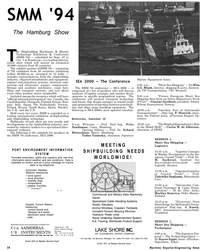 )
September 1994 - Maritime Reporter and Engineering News page: 36
)
September 1994 - Maritime Reporter and Engineering News page: 36Federal Assoc. of German Seaport Op- erators 10:25 a.m. "The Shipbuilding Industry's Role in the Modal Shift" — Carlos M. de Albornoz, chairman of AWES SESSION 1: Short Sea Shipping — Logistics 11:15 a.m. "Logistics Concepts & Market Development in the Eu- ropean Coastal Trade" — Prof. Dr
-
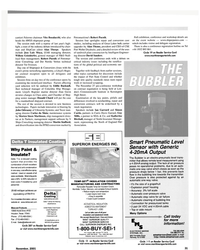 )
November 2001 - Maritime Reporter and Engineering News page: 31
)
November 2001 - Maritime Reporter and Engineering News page: 31cantieri Palermo chairman Vito Busalacehi, who also heads the AWES shiprepair group. The session ends with a reprise of last year's high- light, a state of the industry debate introduced by chair- man and ShipCare editor Alan Thorpe. Speakers include Jose Luis Moya, 1ZAR managing director; Willem
-
 )
November 2001 - Maritime Reporter and Engineering News page: 30
)
November 2001 - Maritime Reporter and Engineering News page: 30organiz- ers Lloyd's List Events, a pre-confer- ence workshop on November 27 — held in conjunction with the annual meetings of the trade associations AWES and SSA — will focus on negotiating new- build, conversion and repair contracts. In the main conference, the impact of world events will be assessed
-
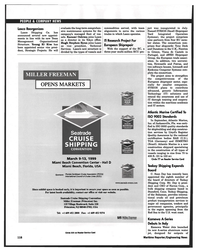 )
November 1998 - Maritime Reporter and Engineering News page: 118
)
November 1998 - Maritime Reporter and Engineering News page: 118mem- ber states. The consortium com- prises four shipyards: Tyne Dock and Dunstons in the U.K., Neorion in Greece, Viana do Castelo in Portugal, and AWES Shiprepair Group, the European trade associ- ation. In addition, two universi- ties, Newcastle and Patras, and two software houses, Intrasoft
-
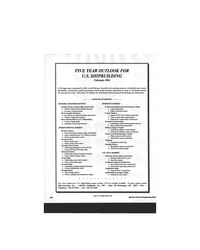 )
April 1994 - Maritime Reporter and Engineering News page: 118
)
April 1994 - Maritime Reporter and Engineering News page: 11818 statistical tables document the findings and conclusions. OUTLINE OF REPORT GENERAL BUSINESS SETTING Analysts Views on Future Ship Construction • AWES, ASIS and World Bank forecasts • Accuracy of past forecasts The Competitive Situation • Key players in commercial ship construction a Trend
-
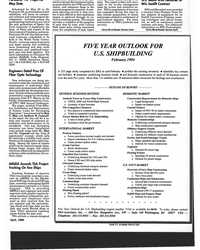 )
March 1994 - Maritime Reporter and Engineering News page: 85
)
March 1994 - Maritime Reporter and Engineering News page: 8518 statistical tables document the findings and conclusions. OUTLINE OF REPORT GENERAL BUSINESS SETTING Analysts Views on Future Ship Construction • AWES, ASIS and World Bank forecasts • Accuracy of past forecasts The Competitive Situation • Key players in commercial ship construction • Trend
-
 )
July 1993 - Maritime Reporter and Engineering News page: 59
)
July 1993 - Maritime Reporter and Engineering News page: 59and MarAd requirements for fire load. For more information on Turnbull, Circle 119 on Reader Service Card Henemann, Saez Chosen As New Leaders Of AWES Frederich Henemann of Bremer Vulkan and Juan Saez of Astilleros Espanoles are the new chairman and vice chairman respec- tively of the Association
-
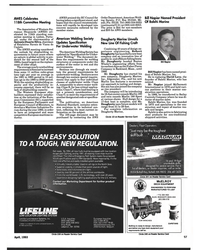 )
April 1993 - Maritime Reporter and Engineering News page: 55
)
April 1993 - Maritime Reporter and Engineering News page: 55AWES Celebrates 118th Committee Meeting The Association of Western Eu- ropean Shipyards (AWES) cel- ebrated its 118th standing com- mittee meeting in Lisbon, Portu- gal, under the chairmanship of Antonio Duarte Silva, chairman of Estaleiros Navais de Viana do Castelo. The AWES meeting
-
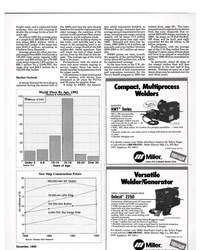 )
December 1992 - Maritime Reporter and Engineering News page: 51
)
December 1992 - Maritime Reporter and Engineering News page: 51. Life extension is most pronounced for oil tankers, with service lives estimated at 23 years for VLCCs and 25 years for smaller ships. A study by AWES, the associa- tion which represents builders in Western Europe, forecasts that the average annual requirement for new ships, including non-cargo-carry
-
 )
October 1992 - Maritime Reporter and Engineering News page: 60
)
October 1992 - Maritime Reporter and Engineering News page: 60and their application Speaker to be confirmed, Courtaulds Coatings/ International Paint, UK The EEC View on Shipyard Discharge S Alewijn, AWES Environmental Committee, Netherlands The organisers reserve the right to amend this programme REGISTRATION We wish to make Conference Registration(s)
-
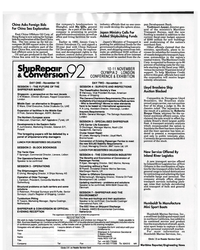 )
September 1992 - Maritime Reporter and Engineering News page: 66
)
September 1992 - Maritime Reporter and Engineering News page: 66and their application Speaker to be confirmed, Courtaulds Coatings/ International Paint, UK The EEC View on Shipyard Discharge S Alewijn, AWES Environmental Committee, Netherlands The organisers reserve the right to amend this programme REGISTRATION We wish to make Conference Registration(s)
-
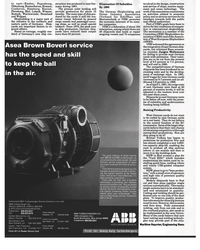 )
September 1992 - Maritime Reporter and Engineering News page: 60
)
September 1992 - Maritime Reporter and Engineering News page: 60. The association is a member of the Committee of EEC Shipbuilders As- sociation (CESA) and of the Associa- tion of West European Shipbuilders (AWES). VSM welcomed the agreement on the integration of east German ship- yards, but criticized Bonn econom- ics minister Jurgen Mollemann for failing
-
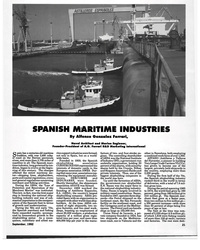 )
September 1992 - Maritime Reporter and Engineering News page: 19
)
September 1992 - Maritime Reporter and Engineering News page: 19basis. Founded in 1959, the Spanish shipbuilding association CONSTRUNAVES represented the interests of domestic yards in the European association AWES. Dur- ing that same year , associations rep- resenting the equipment manufac- turers, SERCOMBE and INDUNARES, were founded. Shortly thereafter
-
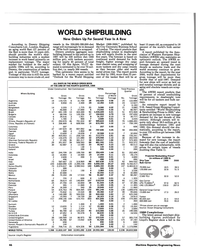 )
June 1989 - Maritime Reporter and Engineering News page: 42
)
June 1989 - Maritime Reporter and Engineering News page: 42years old, as compared to 18 percent of the world's bulk carrier fleet. A report published by the Asso- ciation of Western European Ship- builders (AWES) also maintains an optimistic outlook. The AWES re- port forecasts an upward trend in tonnage demand during the next decade as seaborne trade
